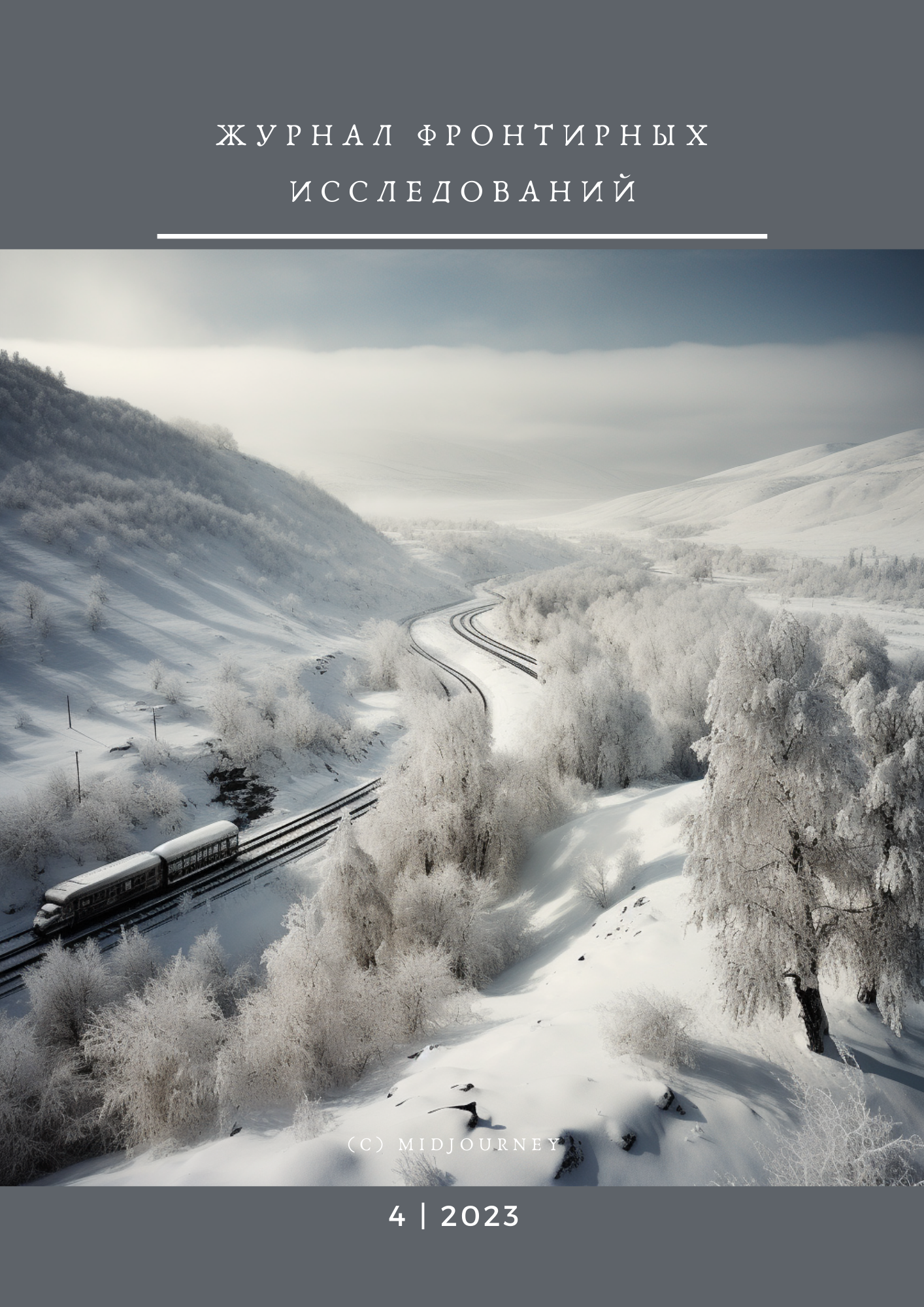Abstract
The study of behavioral practices of children in borderlands intersects two pivotal historical-anthropological research domains: childhood history and border studies. This article delves into unattended border crossings by children in the Karelian region of the Russian-Finnish borderlands during the 1920s. We present the results from an analysis of the two source sets housed in the Republic of Karelia National Archives. These sources comprise formal documents: questionnaire forms completed by teenagers upon their return from Finland and records from interrogations conducted by children’s social security bodies and national security agencies. We identified the factors and circumstances surrounding the illegal movements of underage citizens across the Russian-Finnish borderlands. Our findings reveal that the majority of these young border trespassers were ethnic Karelian teenage boys from borderland villages. The reasons and motivations for crossing the border from Russia to Finland, and subsequently returning home, evolved over time. While personal survival was the primary motivation during the civil war, in more peaceful times, the prevalent drive to go to Finland was economic – to earn money to improve living conditions for both the individual and their parents, reflecting a family survival strategy. We also detail how authorities addressed these transgressions. We conclude that the behavioral practices of these children, in violating national borders, depict them as autonomous actors on one side, yet also highlight their profound dependence on the immediate environment, shaped by its unique political, social, and geographical nuances, on the other.
References
Akesson, B. (2014). Arrested in Place: Palestinian Children and Families at the Border. In Children and Borders (pp. 81–98). Palgrave Macmillan. https://doi.org/10.1057/9781137326317
Borderland Studies Meets Child Studies. A European Encounter. (2017). Peter Lang. https://doi.org/10.3726/b1155910.3726/b11559
Chebakovskaya, A. V. (2019). Working with Juvenile Offenders in Karelia During the Post-Revolutionary Period. Proceedings of Petrozavodsk State University, 8, 93–101. https://doi.org/10.15393/uchz.art.2019.418 (In Russian).
Deti GULAGa. 1918–1956. (2002). MFD. (In Russian).
Graciozi, A. (2008). Novye arhivnye dokumenty sovetskoj jepohi: Istochnikovedcheskaja kritika. Otechestvennye zapiski, 4. https://strana-oz.ru/2008/4/novye-arhivnye-dokumenty-sovetskoy-epohi-istochnikovedcheskaya-kritika (In Russian).
Halicka, B. (2017). The Everyday Life of Children in Polish-German Borderlands During the Early Postwar Period. In Borderland Studies Meets Child Studies: A European Encounter (pp. 116–137). Peter Lang. https://doi.org/10.3726/b11559
Iljuha, O. P. (2012). Povsednevnost' sovetsko-finljandskogo pogranich'ja 1930-h godov v vospominanijah o detstve. Trudy Karel'skogo nauchnogo centra RAN, 4, 124–133. (In Russian).
Ilyukha, O. (2019). Soviet and post-Soviet borders in texts for children and as perceived by children: Symbolic figures, images, meanings. In Borders and Memories. Conflicts and Co-operation in European Border Regions (pp. 31–50). LIT Verlag.
Izvestija Oloneckogo gubernskogo ispolkoma Sovetov krest'janskih, rabochih i krasnoarmejskih deputatov. (1918). Petrozavodsk, 255, 3. (In Russian).
Kaisto, V., & Brednikova, O. (2019). Lakes, Presidents and Shopping on Mental Maps: Children’s Perceptions of the Finnish-Russian Border and the Borderland. Fennia – International Journal of Geography, 1, 58–76. https://doi.org/10.11143/fennia.73208
Kilin, Ju. M. (1999). Karelija v politike sovetskogo gosudarstva. 1920–1941. Izdatel'stvo Petrozavodskogo gosudarstvennogo universiteta. (In Russian).
Ljublinskij, P. I. (1923). Bor'ba s prestupnost'ju v detskom i junosheskom vozraste: Social'no-pravovye ocherki. Juridicheskoe izdatel'stvo Narkomjusta. (In Russian).
Musaev, V. I. (2007). Rossija i Finljandija: Migracionnye kontakty i polozhenie diaspor (konec XIX v. – 1930-e gg.). Izdatel'stvo Politehnicheskogo universiteta. (In Russian).
National Archive of the Republic of Karelia (NARK). (n. d.-a). F. R-282. In. 3. C. 90, 91, 107, 110, 114. (In Russian).
National Archive of the Republic of Karelia (NARK). (n. d.-b). F. R-689. In. 14. C. 1, 2, 3, 10, 13, 15. (In Russian).
National Archive of the Republic of Karelia (NARK). (n. d.-c). F. R-836. In. 1. C. 90, 91, 92. (In Russian).
Nygård, T. (1980). Itä-Karjalan pakolaiset. 1917–1922 [Refugees from East Karelia. 1917-1922]. Jyväskylän yliopisto. (In Finnish).
Osorina, M. V. (2008). Sekretnyj mir detej v prostranstve mira vzroslyh. Piter. (In Russian).
Postanovlenie VCIK ot 1 ijunja 1922 g. «O vvedenii v dejstvie Ugolovnogo kodeksa RSFSR». (1922). https://docs.cntd.ru/document/901757375 (In Russian).
Repuhova, O. Ju. (2017a). Pogranichnyj rezhim v Karelii v 1920–1930-e gody. Izdatel'stvo PetrGU. (In Russian).
Repuhova, O. Ju. (2017b). Pogranichnyj rezhim v Karelii v 1920-h gg. Vestnik Universiteta Dmitrija Pozharskogo, 3(7), 156–175. (In Russian).
Romanova, A. P., & Jakushenkov, S. N. (2012). Frontirnaja teorija: Novyj podhod k osmysleniju social'no-politicheskoj i jekonomicheskoj situacii na Juge Rossii. Innovatika i jekspertiza, 2, 74–80. (In Russian).
Rupasov, A. I., & Chistikov, A. N. (2016). Sovetsko-finljandskaja granica. 1918–1938 gg. Izdatel'stvo «Avrora». (In Russian).
Sandberg, M. (2016). Restructuring Locality: Practice, Identity and Place-Making on the German‑Polish Border. Identities, 23(1), 66–83. https://doi.org/10.1080/1070289X.2015.1016523
Takala, I. R. (2016). «Granica na zamke!». Osobennosti gosudarstvennogo terrora v karel'skom prigranich'e 1920-h – pervoj poloviny 1930-h gg. Al'manah severoevropejskih i baltijskih issledovanij, 1, 132–159. (In Russian).
Usacheva, E. V. (2021). Karel'skie bezhency. Doroga domoj. Periodika. (In Russian).
Venken, M., Kaisto, V., & Brambilla, Ch. (2021). Children, Young People and Borders: A Multidisciplinary Outlook. Journal of Borderlands Studies, 36(2), 149–158. https://doi.org/10.1080/08865655.2021.1898447
Vituhnovskaja-Kauppala, M. A., & Osipov, A. Ju. (2021). V puchine grazhdanskoj vojny: Karely v poiskah strategij vyzhivanija. 1917–1922. Nestor-Istorija. (In Russian).
Zaerko, A. L. (2002). Krovavaja granica (1918–1939). Kameron-D. (In Russian).
Zotova M., Gritsenko A., & Sebentsov A. (2018). Everyday Life in the Russian Borderlands: the Motives and Determinants of Cross-border Practices. Mir Rossii, 4, 56–77. https://doi.org/10.17323/1811-038X-2018-27-4-56-77 (In Russian).

This work is licensed under a Creative Commons Attribution 4.0 International License.


